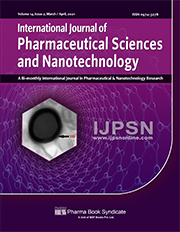Mechanism Underlying the Inhibitory Effect of Bio-synthesized Silver Nanoparticle on TNF-α induced NF- κB Nuclear Translocation in Prostate Cancer Cells
DOI:
https://doi.org/10.37285/ijpsn.2021.14.2.5Abstract
Apoptosis, a physiological mechanism of highly orchestrated cell death, can be initiated by extracellular and intracellular mechanisms that trigger a complex machinery of proapoptotic proteases and mitochondrial changes, leading to the activation of specific endonucleases and DNA fragmentation. The present study was undertaken to elucidate a mechanism underlying the inhibitory effect of biosynthesised silver nanoparticle on TNF-α induced NF-κB nuclear translocation in prostate cancer PC- 3 cells. The cell cycle analysis of Prostate cancer PC-3 cells was examined by flow cytometry by using annexin V-FITC/PI staining. Effect of silver nanoparticles in oxidative stress ROS, Effect of biosynthesized silver nanoparticle on apoptosis in human prostate cancer cell line and apoptotic induction of TNF-α and NF-κB expression was studied by Flow cytometry in Prostate cancer PC-3 cell line. From the results it was observed that biosynthesized silver nanoparticle inhibits the cellular growth of human prostate cancer PC-3 cells and induces apoptosis. The ROS levels generated in response to silver nanoparticles were significantly higher in treated PC-3 cells than the control. The result indicates that cell death is mediated by ROS production, which might alter the cellular redox status, and it is a potential reason for cell death. Apoptosis of the silver nanoparticle treated PC-3 cells was accompanied by a reduction in the percentage of cells in G0/G1 phase and an increase in the percentage of G2/M phase cells, indicating cell cycle arrest at G2/M phase, and transcription factor NF-κB plays an essential role in inflammation and cancer. The activation of NF-κB in response to inflammatory cytokine such as TNF-α promotes nuclear migration to enable DNA-binding activity and facilitate target genes expression.
Downloads
Metrics
Keywords:
Apoptosis, Flow cytometry, TNF, Silver nanoparticle, NF-kB, Prostate cancerDownloads
Published
How to Cite
Issue
Section
References
Aggarwal BB (2003). Signalling pathways of the TNF super family, a double edged sword. Nat Rev Immunol 3: 745-756.
Chang, H., Huang, H., Huang, T., Yang, P., Wang, Y. and Juan, H (2013). Flow Cytometric Detection of Reactive Oxygen Species. Bio-protocol 3(8): 431.
Chung, Y.L., Aditya, A., Cheah, F. K., Bushra, M., Leong, K. H., et al., (2013). Induction of apoptosis in Human Breast Cancer Cells via Caspase pathway by Vernodalin isolated from Centratherum anthel-minticum (L.) Seeds, PLOS one 8(2): 56643
D.L. Bemis, J.L. Capodice, P. Gorroochurn, A.E. Katz and
R. Buttyan (2006). Anti-prostate cancer activity of a ß-carboline alkaloidenriched extract from Rauwolfia vomitoria. International journal of oncology 29: 1065-1073.
Dalia Hussein Soliman, Amel Mostafa Farrag and Ola Omran (2017). Design, Synthesis and In-Silico Studies of Novel Chalcones as Anti-Prostate Cancer and Cathepsin B Inhibitors. Journal of Applied Pharmaceutical Science 7(07): 010-020.
Heidenreich, A., Aus, G., Bolla, M., Joniau, S., Matveev, V.B., Schmid, H.P., Zattoni (2008). European association of urology. EAU Guidelines on prostate cancer. Eur Urol. 53:68-80.
Jin Z and El-Deiry WS (2005). Overview of cell death signaling pathways. Cancer Biol Ther 4: 139–163
K.Rajathi, N. Kannikaparameswari and S. Suja (2017). In vitro Cytotoxicity testing of biosynthesised silver nanoparticles of Andredera Cordifolia in prostate cancer cells (PC-3). Ejpmr. 4(1): 401-407.
Khan, Numan M1, Ali M, Khali AT, Ali T, Abbas N and Shinwari ZK (2017). Bio-Synthesized Silver Nanoparticles Using Different Plant Extracts as Anti-Cancer Agent. J. Nanomedine Biotherapeutic Discov. 7(2).
Kuo, S.M., (1997). Dietary flavonoids and cancer prevention: evidence and potential mechanism. Crit Rev Oncogenesis 8: 47- 69.
Nakashima, J., Tachibana, M., Ueno, M., Miyajima, A., Baba, S. and Murai, M (1998). Association between tumor necrosis factor in serum and cachexia in patients with prostate cancer. Clin. Cancer Res., 4: 1743 -1748.
Puja Khanna, Cynthia Ong, Boon Huat Bay and Gyeong Hun Baeg (2015), Nanotoxicity: An Interplay of Oxidative Stress, Inflammation and Cell Death, Nanomaterials, 5: 163-1180.
R. I. Priyadharshini, G. Prasannaraj, N. Geetha and P. Venkatachalam (2014). Microwave-Mediated Extracellular Synthesis of MetallicSilver and Zinc Oxide Nanoparticles Using Macro-Algae (Gracilaria edulis) Extracts and Its Anticancer
Activity Against Human PC3 Cell Lines. Appl Biochem Biotechnol. 174: 2777–2790.
Rajnish gupta (2019). Cadmium nanoparticles and its toxicity.
Journal of Critical Reviews. 6(5): 1-7.
Selvarani S, Moorthi PV, Saranya P and Abirami M, (2015). Anti- Cancer Activity of Silver Nanoparticle Synthesized from Stem Extract of ocimum Kilimandscharicum against Hep-G2, Liver Cancer Cell Line. Journal of Nanotechnology & Nanoscience. 1(1): 1-7.
Shanmugam, M.K., Ong, T.H., Prem Kumar, A., Lun, C.K., Ho, P.C., Wong, P.T.H., Hui, K.M. and Sethi, G., (2012). Ursolic acid inhibits the initiation, progression of prostate cancer and prolongs the survival of Tramp mice by modulating pro- inflammatory pathways. PLOS ONE, www.plosone.org. 7(3): 32476.
Simon, H.U., Haj-Yehia, A. and Levi-Schaffer, F (2000). Role of reactive oxygen species (ROS) in apoptosis induction, Apoptosis. 5: 415–418.
Sonn, G.A., Aronson, W., and Litwin, M.S (2005). Impact of diet on prostate cancer: a review. Prostate Cancer Prostatic Dis 8: 304– 310.
Tsuneo Ishida,(2017). Anticancer activities of silver ions in cancer and tumor cells and DNA damages by Ag+ - DNA base-pairs reactions. MOJ Tumor Res.1(1): 8-16.
V. Suseela and G. Lalitha (2015). Cytotoxic effect of green synthesized silver nanoparticles using Indigofera longeracemosa on skin cancer sk mel-28 cell lines. International Journal of Preclinical & Pharmaceutical Research. 6(3): 118-125.
Vaidyanathan, R., Kalishwaralal, K., Gopalram, S. and Gurunathan, S (2009). Nanosilver-the burgeoning therapeutic molecule and its green synthesis. Biotechnol Adv. 27 (6): 924-937.
Vasundhara Venkateswaran, Neil Fleshner, Linda M. Sugar, and Laurence H. Klotz (2004). Antioxidants block prostate cancer in Lady transgenic mice. Cancer Research. 64; 5891-5896.
Wagner, V., Dullaart, A., Bock, A.K. and Zweek, A (2006). The emerging nanomedicine landscape. Nat Biotechnol. 24(10): 1211- 1217.
Wang, X. and Lin, Y (2008). Tumor necrosis factor and cancer, buddies or foes? Acta Pharmacol sin. 29: 1275-88.
Yezhelyev, M.V., Gao, X., Xing, Y., Al-Hajj, A., Nie, S. and O'Regan,
R.M (2006). Emerging use of nanoparticles in diagnosis and treatment of breast cancer. Lancet Oncol. 7(8): 657-667.






